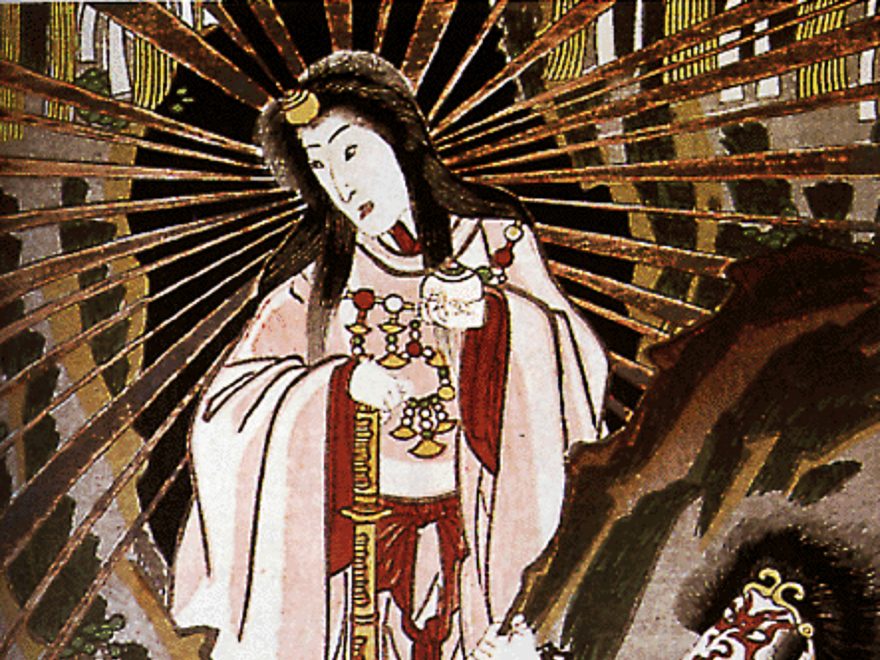| Part of the series on Japanese Mythology & Folklore | |
 | |
| Mythic Texts and Folktales: Kojiki | Nihon Shoki | Fudoki Kujiki | Kogo Shūi | Nihon Ryōiki Otogizōshi | Oiwa | Okiku | Urashima Tarō Konjaku Monogatari | |
| Divinities Izanami | Izanagi | Amaterasu Susanoo | Ame-no-Uzume | Inari Kami | Seven Lucky Gods | List of divinities | |
| Legendary Creatures & Spirits Oni | Kappa | Tengu | Fox | Yōkai Dragon | Yūrei | List of creatures | |
| Legendary Figures Abe no Seimei | Benkei | Kintarō Momotarō | Tamamo-no-Mae | Sōjōbō | |
| Mythical & Sacred Locations Mt. Hiei | Mt. Fuji | Izumo | Ryūgū-jō | Takamagahara | Yomi | Jigoku | |
| Sacred Objects Amenonuhoko | Kusanagi | Tonbogiri Three Sacred Treasures | |
| Shintō & Buddhism Bon Festival | Setsubun | Ema | Torii Shinto shrines | Buddhist temples | |
| Folklorists Kunio Yanagita, Keigo Seki, Lafcadio Hearn, Shigeru Mizuki, Inoue Enryo | |
Japanese folklorists and historians use yōkai as "supernatural or unaccountable phenomena to their informants". In the Edo period, many artists, such as Toriyama Sekien, created yōkai inspired by folklore or their own ideas, and in the present, several yōkai created by them (e.g. Kameosa and Amikiri, see below) are wrongly considered as being of legendary origin
Contents |
Types
There are a wide variety of yōkai in Japanese folklore. In general, yōkai is a broad term, and can be used to encompass virtually all monsters and supernatural beings, even including creatures from European folklore on occasion (e.g., the English bugbear is often included in Japanese folklore to the point that some mistakenly believe it originates from said folklore).Animals

Many indigenous Japanese animals are thought to have magical qualities. Most of these are henge (変化), which are shapeshifters (o-bake, bake-mono[2]) that often appear in human form, mostly women. Some of the better known animal yōkai include the following:
- Tanuki (raccoon dogs)
- Kitsune (foxes)
- Hebi (snakes)
- Mujina (badgers)
- Ōkami (wolves)
- Bakeneko (cats)
- Tsuchigumo and jorōgumo (spiders)
- Inugami (dogs)
Oni
One of the most well-known aspects of Japanese folklore is the oni, which is a sort of mountain-dwelling ogre, usually depicted with red, blue, brown or black skin, two horns on its head, a wide mouth filled with fangs, and wearing nothing but a tigerskin loincloth. It often carries an iron kanabo or a giant sword. Oni are mostly depicted as evil, but can occasionally be the embodiment of an ambivalent natural force. They are, like many obake, associated with the direction northeast.Tengu
A goblin from Japanese mythology that has several supernatural powers and skills in martial arts, the tengu were originally extremely dangerous demons and enemies of Buddhism, but over centuries, their behavior changed from a spirits of the damned to active defenders of Dharma.Tsukumogami
Tsukumogami are an entire class of yōkai and obake, comprising ordinary household items that have come to life on the one-hundredth anniversary of their birthday. This virtually unlimited classification includes:- Bakezōri (straw sandals)
- Biwa-bokuboku (a lute)
- Bura-bura (a paper lantern)
- Karakasa (old umbrellas)
- Kameosa (old sake jars)
- Morinji-no-kama (tea kettles)
- Mokumokuren (paper screens with eyes)
Human transformations

- Rokuro-kubi (humans able to elongate their necks during the night)
- Ohaguro-bettari (a figure, usually female, that turns to reveal a face with only a blackened mouth)
- Futakuchi-onna (a woman with a voracious extra mouth on the back of her head)
- Dorotabō (the risen corpse of a farmer, who haunts his abused land)
Other
Some yōkai are extremely specific in their habits, for instance:- Azuki Arai (a yōkai who is always found washing azuki beans).
- Akaname (only found in dirty bathrooms and spends its time licking the filth left by the untidy owners).
- Ashiarai Yashiki (A gargantuan foot that appears in rooms and demands the terrified home owner washes it)
- Tofu Kozo (a small monk who carries a plate with a block of tofu).
In media
Various kinds of yōkai are encountered in folklore and folklore-inspired art and literature.Famous Works and Authors
Lafcadio Hearn's collection of Japanese ghost stories entitled Kwaidan: Stories and Studies of Strange Things includes stories of yūrei and yōkai such as Yuki-onna, and is one of the first Western publications of its kind. In Japan, yōkai are particularly prevalent in manga, anime and Japanese horror. Shigeru Mizuki, the manga creator of such series as GeGeGe no Kitaro and Kappa no Sanpei, keeps yōkai in the popular imagination. With the exception of four volumes of GeGeGe no Kitaro, however, Mizuki's works have yet to be translated into English. The same goes for Shiibashi Hiroshi, the manga creator of Nurarihyon no Mago and Nurarihyon no Mago: Sennen Makyou .Yōkai have continued to be a common theme in modern works of fiction. They served as the stars in the 1960s Yokai Monsters film series, which was loosely remade in 2005 as Takashi Miike's The Great Yokai War. They often play major roles in Japanese fiction.
Synonyms to yōkai
Instead of yōkai, sometimes the word mononoke (written 物の怪) is used. It carries the meanings of "monster", "ghost" or "spirit", and the literal meaning is "the spirit of a thing" or "strange thing".[4] This word is used to blame any unexplainable event on, and both inanimate objects and spirits of humans and other creatures can be called mononoke. Several anime have dealt with mononoke, perhaps most famously Princess Mononoke (where the spelling of the word is simplified as もののけ).Source: From Wikipedia, the free encyclopedia
No comments:
Post a Comment